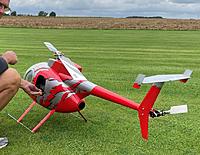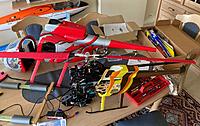-
 Views: 19
Views: 19
looking aft to forward in the tail of the Blanik showing the extra carbon matting that has been balloon pressed to follow the contours of the fuselage into the vertical tail plus carbon rods into vertical tail -
 Views: 17
Views: 17
A nice picture of my charming Göppingen4 coming in to land with spoilers in the green environment of Ter Apel in the North Netherlands -
 Views: 22
Views: 22
My photogenic 5m Foka4 under tow at Pottes in 2023, with threatening sky in the background -
Views: 18
This is how the machine cut parts of my 2 Starfighters arrived. It will be a challenge to convert these piles into flying models with only pictures for help, no assembly notice being provided. -
 Views: 13
Views: 13
Possible runway axis on the much enlarged model airfield of TMV at Henis (Tongeren), with up to 175m lengths available! on smooth mulched well maintained grass -
Views: 18
smaller old 70mm EDF's were removed and nacelles adapted to accept more powerfull Galaxy X7 V2 EDF's
Comments (0)
Add Comment
-
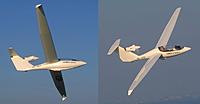 Views: 31
Views: 31
One of the rare airborne shots of a full-size Windex showing the lines of this stubby powered glider in relation to the size of a pilot -
 Views: 46
Views: 46
Me watching how seller Jörg assembles the model before I loaded it in the camper for the long trip back to Belgium. -
 Views: 38
Views: 38
The original electronics with all the Jeti stuff from the seller still in place -
 Views: 36
Views: 36
Stickers everywhere and a rather flexible baseplate with forward plate holding the nose in plate because of lack of aft support -
Views: 41
Lenghtened outrigger wheel fairings in primer and new screw in attachment of endplates on T-bolt in wing end. Wing root shows max physical limited down deflection of the flaps -
Views: 53
The terrace is just wide enough for a full assembly before the first weight and ballance with a much too weak Sig ballancer. -
Views: 38
After rearranging the Rx batteries so as to be able to play with the CG during the testflights. Additional hook servo installed and Jeti sensors of previous owner removed and shipped back to him -
Views: 41
The green styro angled plate blocked between my standard wooden bars. At the back it supports the wing salmons, The old plate slides over it and prevents the nose from hitting the camper door. A strap around the engine fairing holds everything in place.
-
 Views: 30
Views: 30
The real U2A 66722 descending with full flaps and airbrakes out -
 Views: 19
Views: 19
U2A 66722 has only been used for science, shown here after its deployement to Australia at the end of the sixties to study the high altitude clear air turbulence (and winds) all over the globe for project HICAT -
 Views: 21
Views: 21
My model under tow for its forth testflight at the 2023 BiGGS meet at Pottes. Besides its Kangaroo zap fro mis Australian deployment, it also sports the polar bear zap after its Alaskan deployment
-
 Views: 59
Views: 59
My Fouga about to touch down with takeoff flaps and scale-spoilers half-out. A thing of beauty that flies exceptionally well. -
 Views: 92
Views: 92
Geert and I posing just before lining up for a formation flight with our matching Freewing T33's in Belgian colors at the annual IFF EDF meet at Wey in Germany -
 Views: 74
Views: 74
The damage to my Nipper was extensive after its self inflicted takeoff crash at Wiekevorst airshow: Nose broke off and nosewheel + steering damages, main wing spar of port wing broke off at root and much other damage to be repaired -
 Views: 63
Views: 63
My Hangar 9 based B25 during a top view pass looks alpost real. The functioning pitot boom is placed as the front nose-gun and doesn't detract from the scale view -
 Views: 61
Views: 61
Some impressive examples of the 70+ gliders waiting to be towed at the 2022 Bastogne international meet -
 Views: 56
Views: 56
First outside pictures of my FlyFly Hunter before further preparations for the maiden
-
 Views: 47
Views: 47
Picture of the Belgian Red Devils national aerobatic team somewhere during an airshow. I choose this acrft ID77 as an example for my model, sporting the light gray range radar radome while others sometimes had a black one. -
 Views: 58
Views: 58
Horrendoes wing warps in all possible twist modes as they came out of the box after removal of their individual plastic bag covers. Some people would (wisely?) give up at this stage -
 Views: 53
Views: 53
Many weights, flat surface and steam or hot air can correct warps out a bit, but using new balsa leading and trailing edges are a more permanent solution -
 Views: 60
Views: 60
The ailerons with their new balsa leading and trailing edges amidst the two wings kept flat with a lot of various available weights -
Views: 65
All the cut out leading and trailing edges shown in front of other panels having been stripped of their factory paint -
Views: 57
Elevator servo's repositioned for aiurstream oriented actuators and both servo's operated in sync by a single channel without the use of of unreliable servo-reversers. -
 Views: 50
Views: 50
New carbon wing spar in place with servo and main gear spaces cut. Room made for GFK operating split flaps -
 Views: 52
Views: 52
This wing center section should have rested completely flat on the table but was seriously twisted both longitudinally and transversally.
-
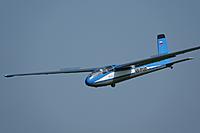 Views: 69
Views: 69
My trusted old Blanik model could easily be confused for a real one in flight -
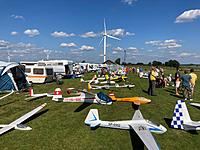 Views: 73
Views: 73
Crowded gathering of towed gliders at Bastogne in 2021. Narrow downslope runway with windmills nearby -
 Views: 83
Views: 83
The RBC Fouga having been sheeted on the top, lots of traditional woodwork with thin strips glued next to eachother.
-
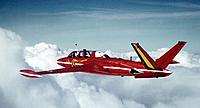 Views: 107
Views: 107
Enroute to Corsica above the clouds. When still in use as a pilot trainer they depolyed to the shooting range in Solenzara for guns, rocket and bombs drops. It took a few hops to get there but as the aircraft deployed for a few weeks that was no problem -
 Views: 103
Views: 103
Everything comes neatly packed and protected in a solid carton box containing so much that nothing can move underway. -
Views: 116
half the content around the plan, note that for this picture I did not separate the packs containing all the wooden stringers, sheeting, beams and spars. The clear canopy comes protected and comprised two parts that have to be glued to eachother -
Views: 100
The other half with the many CNC well-cut parts in their protective sheets, all still unmarked but easy to identify on the sheet depictions printed along the plan -
Views: 110
I cut the detailed trtue-size color-coded plan in sections that were laid down on the narrow worktable during each sub-assembly -
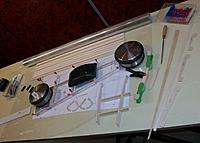 Views: 113
Views: 113
Starting with the tail feathers, the frame is pinned down on the plan and weights used to keep everything perfectly flat during drying -
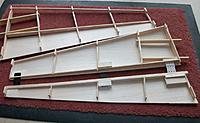 Views: 123
Views: 123
I choose to build the fixed and movable sections apart, each with parts moving invisibly in eachother like knuckles. Those hinges got balsa reinforcements to keep them strongly in place after the model is painted -
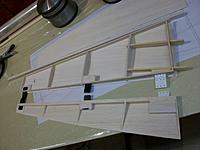 Views: 130
Views: 130
My way of assembly with offset hinges (the hinge lines on the picture are where they'll end up after final assembly) to obtain a joint without gaps on the model
-
 Views: 175
Views: 175
My personal F104 FX65 as pictured at the end of the 1978 Tactical Air Meet at Wildenrath (RAFG) with tips, pylons and Su21 dispencer. During the last days, crew chiefs of various other detachments kept on adding badges and emblems to our port fuselage. -
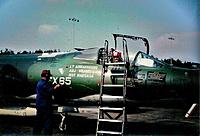 Views: 192
Views: 192
After startup for a so called full-mission, note large 1/50.000maps along windshield. Pilot, crew chief and electronic specialist were dedicated to their aircraft during 2 months, nobody else was allowed to fly/touch it without their presence. -
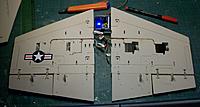 Views: 192
Views: 192
Underside of kit wings showing difference in port an,d starboard servos plus multitude of gutters and mould holes/marks -
 Views: 201
Views: 201
That is how it came out of the box. You can clearly see the relatively important thickness of the minimal semi-symetrical wings. The ugly servo's in the vertical tail deserve a better camouflage. -
Views: 176
After applying and sanding plenty of lightweight filler the model was ready for painting with plastic modeller's Humbrol colors -
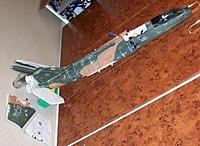 Views: 195
Views: 195
After gluing in the vertical tail and sanding the trailing edges of the wings and tail smooth the model was ready for painting -
 Views: 184
Views: 184
starboard side -
 Views: 183
Views: 183
port side
-
 Views: 134
Views: 134
HeliArtist Agusta 109 body after repainting and application of Caliegraphics artwork -
 Views: 139
Views: 139
The real Agusta A109 in the livery I had the chance to pilot it during a couple of short flights before the turn of the centuries -
Views: 144
On top: the stock Heli-Artist Agusta A109 body shell In the middle: T-Rex500Pro DFC mechanics Bottom: loose heli-artist body parts and calliegraphics artwork -
Views: 145
Finding out how to correctly connect my FrSky receiver via the interface box to the Bavarian Demon Rigid V2 stab system. bottom window for automatic position hold visible at the bottom. -
 Views: 143
Views: 143
Retractable landing gears and actuating servo's mounted in the fuselage during setup and adjustments -
 Views: 146
Views: 146
Those nice body colors had too much thickness to be sprayed or painted over without having the separation lines showing through -
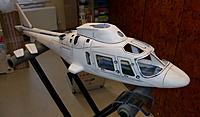 Views: 160
Views: 160
After two days of delicate sanding to the original gelcoat the body was ready for priming. -
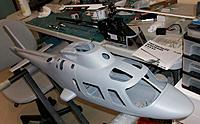 Views: 143
Views: 143
The body in its primer, frame and front window shown in the background
-
 Views: 217
Views: 217
The PA18 I flew for 200 hours as an instructor during the seventies from EBZH for Aeroclub Kiewit in Belgium -
 Views: 116
Views: 116
The model after application of the Calie Grafics Artwork and installation of the pitot tube. -
Views: 218
First setup with batteries in aft position. Receiver Velcro'ed on rooftop, CC10 and FAS 100 electronics in the middle, wooden plate and Velcro strap to prevent batteries from moving during aerobatic maneuvers -
Views: 189
single carbon strip passed through fuselage foam to provide a physical stop/uplock for the flaps during high-G maneuvring -
 Views: 198
Views: 198
At the end of the right final turn and coming in for landing practice with flaps deployed -
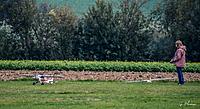 Views: 204
Views: 204
Preparing for a first aerotow with a much too short towline but proving the 4S setup is adequate for Parkzone Ka8b type foam gliders -
Views: 215
FrSky ASS100 sensor system installed with minimum foam cut away in the bottom of the port wing. Later a plastic plate was screwed over the assembly. -
Views: 201
The original landing gear kept in place by just four nylon M5 nuts without any threadlock or other retaining system.
-
 Views: 398
Views: 398
The real SABENA B737-500 OO-SYJ approaching for landing in the mid 90's -
 Views: 411
Views: 411
My 2m span rendering based on a Winrider foam model designed by Ming but unfortunately is not produced anymore -
Views: 406
That is what came out of the large Windrider box -
 Views: 410
Views: 410
I used the nacelles of my first 737 instead of the new ones because I only had to redo the covering while the existing quick engine swap possibility was kept intact. -
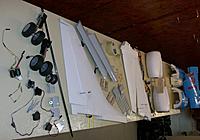 Views: 413
Views: 413
The many parts I recuperated from my first 737 to be incorporated into my second model -
 Views: 403
Views: 403
All the prefabricated parts before being glued to form new wings and stabs -
Views: 413
extra carbon tubes were used to solidify the wing joints, alleviate the stresses on the single wing spar and minimize wing flexing in toto -
 Views: 419
Views: 419
Gluing the flap hinges to the canoes before the complete assembly is mated to the wings
-
 Views: 293
Views: 293
The real C53 N49AG I had the honor to pilot during its brief 1996 airshow season for the commemorations of 50 years Belgian Air Force. This picture was taken at the commemorative airshow at St Truiden (EBST) -
 Views: 292
Views: 292
To the left my old Dynam Skybus, to the right the ZD DC3 "rosinenbomber" as acquired second hand september 2020. Size difference was much more obvious than anticipated by reading just the numbers of the wingspans. -
Views: 292
Old and new next to eachother, together with a choice of props and the custom artwork produced by Caliegraphics -
Views: 301
Attrociously inaccurate aft fuselage of the ZD model compared to the Dynam model in the background -
 Views: 284
Views: 284
I never modified the blunt nose nor the inaccurate engine cowlings of the Dynam model, but on the ZD model things were even worse with highly inaccurate cockpit windows and monsterous fuselage-wing fairings.
-
Views: 306
contents of ASS bags with difference between ASS70 and ASS100 control cards, copper assembly was custom produced by a friend for my Gö4-3 -
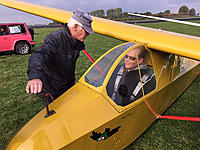 Views: 313
Views: 313
Period copper pitot/static sensors mounted on the nosedeck of a restored antique airworthy glider. That is what I used as the basis for custom produced functional total and static pressure sensors for my 50+year-old gliders -
Views: 291
Early test installation of a stock FrSky pitot tube along the towhook opening. That was dictated by the impenetrable lead-filled nosecone was was delicate for landing and transport. -
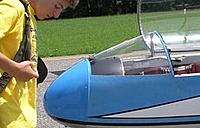 Views: 304
Views: 304
The minimal bent tube just in front of the windscreen of the full-size Blanik I reproduced in quarter-scale. Not the best picture but the only one that illustrates how the tube angle was chosen according to the airflow around the blunt nose -
Views: 301
My reproduction installed slightly higher (initially?) to sense some more "cleaner" air instead of boundery-layer airstream -
Views: 286
After the rubber tube for the total pressure was glued in a hole in the nose, I used a sharp knife to cut it flat with the rest of the nose and it works like a charm, proving the diameter of the hole is not critcal to sensor total air pressure. -
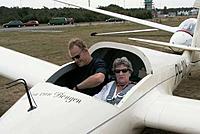 Views: 323
Views: 323
A surviving Dutch Gö4-3 being prepared for launch, the slightly offset pitot-static system in the nose has been painted black (to reduce visual disturbance for the crew?) and points down into the normal glide slope angle airstream -
Views: 313
This is my scale reproduction and installation on my quarter-scale Goevier but I kept it in natural copper to be better visible during handling and transport.
-
 Views: 287
Views: 287
My QF100F model coming in for landing after its second trial flight mid October 2020 at TMV Tongeren -
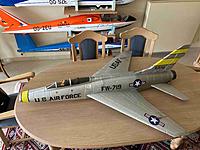 Views: 320
Views: 320
As bought second-hand half a decade before, an impressive model that at first (and with my knowledge at that time) looked good enough for a rebuild, but later proved a major undertaking with mediocre results -
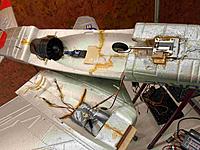 Views: 331
Views: 331
Just looking at how the nosewheel had been attached to the fuselage tells a lot. After removing the wing I discovered many more horrors such as bulbous glue, loose wires and rough-removed foam that destroyed smooth airflow in the intake. -
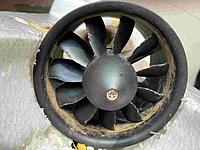 Views: 325
Views: 325
The condition of the EDF was terrible, the rotor had more damage than I ever could imagine and the walls of the shroud were plastered with a clay-like substance. Luckily the later could get cleaned and the motor itself still ran perfectly -
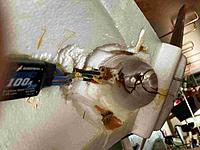 Views: 318
Views: 318
An ESC with only 2% overhead capability, mounted in front of the EDF, and an exhaust cluttered with wxired and connectors are not the combination I was looking for. -
 Views: 325
Views: 325
The new 130Amp ESC was mounted backwards just aft of the EDF and stripped of most of its sleeves to ensure good cooling in the exhaust. All wiring running further aft was plastered into a top gutter and sanded to obtain a smooth obstacle-free exhaust -
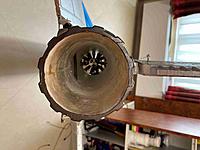 Views: 324
Views: 324
all the wiring running to both elevator servo's also was plastered level within the exhaust wall, the only remaining obstacle being the guide tube for the individually activated full flying stabilizers -
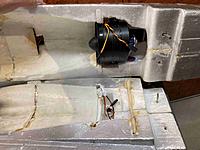 Views: 313
Views: 313
wires for ailerons, main retracts and motor were rerouted into the factory provided cavities above and below the EDF shroud. Intake completely smoothened out and covered with a coat of strong Z-poxy to avoid filler ingestion.
-
 Views: 306
Views: 306
If not told this is an actual picture of the MODEL in flight, you would think it is a real one. This very affordable Freewing foam model is worth every penny and turns heads on the airfield. -
 Views: 314
Views: 314
That is the real one as they were used for training in 1972 at Brustem, note the travel pod under the fuselage and stowed instrument-hood curtain behind the back-seater. Black nomenclature and white nose in that year -
Views: 336
factory decals wiped away with acetone, crevasses on underside of horizontal stab filled out, Humbrol sand color (tan) painted over factory paint and blank foam areas to check covering capability and reactivity -
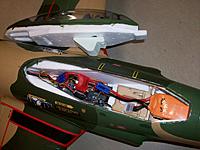 Views: 333
Views: 333
removed the factory blue connection box an replaced by FrSky receiver and Amp sensor, power cables substantially shortened and holdback plates made for two different battery types that are held in place by additional under-canopy foam block. -
Views: 316
FOD screen glued inside the cheater hole to keep out grass and stones, 2mm balsa strip glued under the flap area to prevent the split flaps from raising too high in the airstream and to alleviate the aerodynamic forces on the servos. -
 Views: 342
Views: 342
See how the tan lines vary on the fuselages of 3 different aircraft during student formation practice flights, and how some noses were black and nomenclature white later70's. 11 squadron bat was sometimes applied on various locations on some aircraft -
 Views: 319
Views: 319
Underside of wings got the filler treatment as well as around the plastic intakes. A 4-strand wiring connects the tail to the fuselage. the various green shades were first tested on the tail section -
Views: 317
The finished model on the table, a very handy format for transport and stocking home. To me the VietNam scheme is much more attractive and visible than the factory NATO camouflage
-
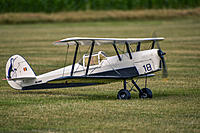 Views: 342
Views: 342
My single-cockpit Stampe taxiing out during development flights is hard to distinguish from its full-size counterpart. From the side it is only black and white, from the bottom only black, from the top only red and white, making it easy for orientatation -
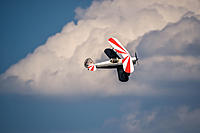 Views: 358
Views: 358
Dramatic top-view low-pass against cumulus clouds -
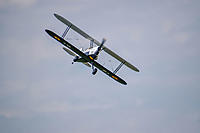 Views: 375
Views: 375
Head-on view clearly showing the port lower inner broken flying wire missing, glad my wings didn't collapse during the aerobatics because those wires are not only for the eyes, they are structural necessities also on the model -
Views: 321
I transport my Stampe fully assembled in my camper, in a foam craddle that I modified from a balancer for glider, holding the biplane in a space efficient nose-down attitude supported by both lower leading edges and the lower fuselage nose
-
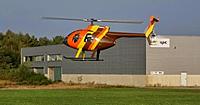 Views: 352
Views: 352
Happily hovering in front of a real helicopter maintenance facility at Zwartberg airport. This is a nice realistic and practical sport-scale trainer heli -
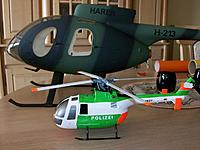 Views: 327
Views: 327
My 500 shell in original Danish Army colors for size comparaison behind my paint-modified Blade 130. To be used vinyl rolls are visible in the back. -
 Views: 348
Views: 348
Freshly and painstakingly covered in vinyl to portray Magnum PI series popular TV series helicopter -
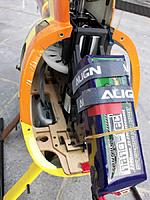 Views: 349
Views: 349
Original battery setup and Helicommand Rigid stabilizer looking down through a small window under the fuselage -
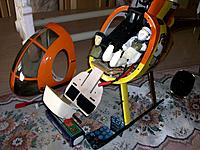 Views: 339
Views: 339
Old original FMS T28 pilot bustes used as a base for foam augmented pilot full pilot figures. Nex exteded forward floor with foam instrumeny console and Velcro for new forward battery position visible -
Views: 366
Painted pilot TJ with his feet resting on top of the transverse positioned battery, ready to take the air. (temporary sensor converter near his head for battery consuption telemetry. -
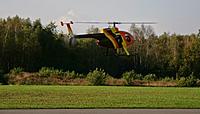 Views: 366
Views: 366
Flying up and down the runway to get acquainted with the delicate art of model helicopter scale flying.
-
 Views: 316
Views: 316
My quarter-scale model with the four spoilers fully extended during finals allows steep approaches to be made over obstacles, with the same pronounced nose-low attitude as his full-size example. Looks pretty real doesn't it? -
 Views: 349
Views: 349
One of the rare pictures of the SZD9b Bocian 1c in the attractive Sabena livery it first wore in 1958. I only found color pictures of OO-SZE in various later less attractive paint schemes, I thus had to do it with this black/white for my model -
 Views: 372
Views: 372
The contents of the basic kit together with the extra order of wood, spoilers, wheel, wing key with furrows, canopy, pilot, seat belts and instrument panel, all nicely packed in two large boxes for transport -
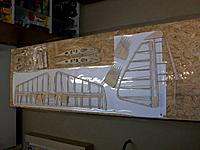 Views: 346
Views: 346
making heaps of pre-cut parts for left and right wing plus ailerons, and dry positioning of the parts required for stab, elevator, fin and rudder -
Views: 366
Using the table edges and judicious positioning of the parts when drying ensures straight sub-assemblies according to the plans. -
 Views: 346
Views: 346
To build the fin I decided to immediately incorporate it to the aft part of the fuselage for correct alignment, but the odd shapes make it difficult to assemble directly on the plan. -
Views: 362
Positioning the Robart large pin hinges for the flight controls to find out the optimum positions before any drilling is done. Easy for the horizontal stab but more thinking required for the rudder because the ribs don't match the ones on the fin -
 Views: 367
Views: 367
The situation after capping the ribs and lots of sanding on the leading edges and tips, dual elevator servo's installed and wiring connector to fuselage prefabricated. One elevator already covered with Oracover and balsa blocks for hinges glued to ribs
-
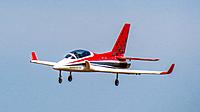 Views: 313
Views: 313
The Viperjet during it's maiden flight 21May2020 from the grassfield of Tongres -
Views: 360
Here you can see that the aftermarket white plastic flight control hinges are completely engulfed by yellowish gorill-type glue, completely blocking any hinge-movements -
Views: 338
Serious damage to the foam and decoration around the hinges after removing the excess glue. Carbon strip glued within the top of the rudder to prevent it from bending too much (in flight and during ground handling) -
Views: 363
Geardoors cut out and fixed to the airframe, allowing for retracts to operate without the nuisance and delicacy of door actuators and servos. -
Views: 384
motor and receiver batteries along eachother rather far back in the fuselage to attain the 100mm recommended CG position. FrSky receiver and its extensive wiring barely visible along the port side, telemetry sensors and regulators along starboard side -
Views: 367
New rack in the bedroom to stock the Stampe SV4b and Viper without detaching the wings. Electric or steel flying wires are a real p.i.a. to assemble on the field.
